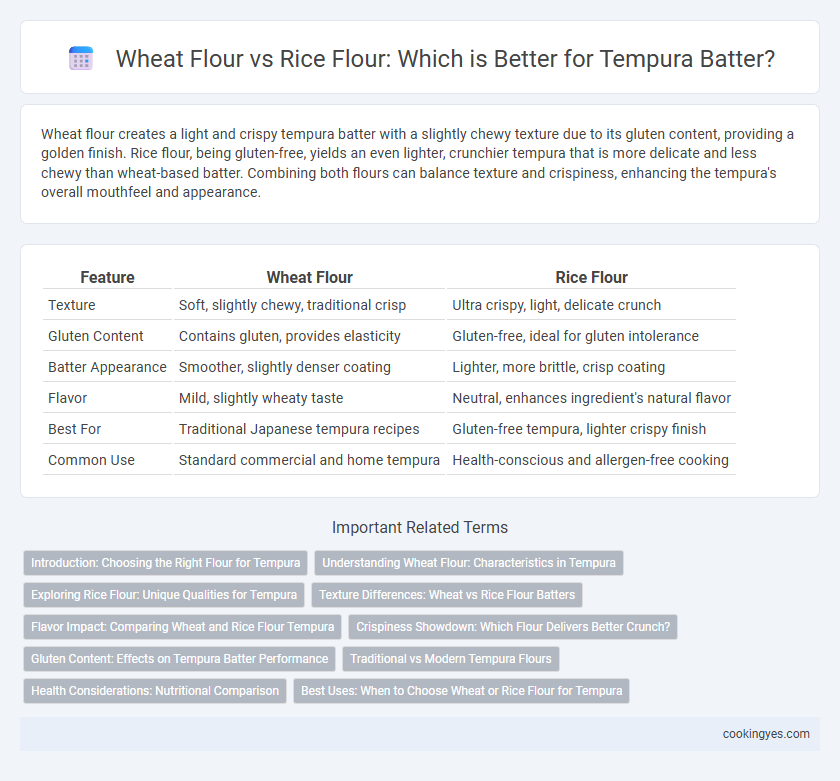Wheat flour creates a light and crispy tempura batter with a slightly chewy texture due to its gluten content, providing a golden finish. Rice flour, being gluten-free, yields an even lighter, crunchier tempura that is more delicate and less chewy than wheat-based batter. Combining both flours can balance texture and crispiness, enhancing the tempura's overall mouthfeel and appearance.
Table of Comparison
| Feature | Wheat Flour | Rice Flour |
|---|---|---|
| Texture | Soft, slightly chewy, traditional crisp | Ultra crispy, light, delicate crunch |
| Gluten Content | Contains gluten, provides elasticity | Gluten-free, ideal for gluten intolerance |
| Batter Appearance | Smoother, slightly denser coating | Lighter, more brittle, crisp coating |
| Flavor | Mild, slightly wheaty taste | Neutral, enhances ingredient's natural flavor |
| Best For | Traditional Japanese tempura recipes | Gluten-free tempura, lighter crispy finish |
| Common Use | Standard commercial and home tempura | Health-conscious and allergen-free cooking |
Introduction: Choosing the Right Flour for Tempura
Wheat flour provides gluten that creates a light, airy texture essential for classic tempura batter, offering a slightly chewy finish. Rice flour, with its gluten-free properties, yields a crispier, more delicate coating that enhances tempura's signature crunch. Selecting between wheat and rice flour impacts the tempura's texture and authenticity, catering to different dietary preferences and desired crispness.
Understanding Wheat Flour: Characteristics in Tempura
Wheat flour is commonly used in tempura batter due to its moderate protein content, which contributes to a light and crispy texture. The gluten formed during mixing provides elasticity, allowing the batter to cling well to ingredients while maintaining a delicate crunch. Lower absorption of oil compared to rice flour results in less greasy tempura, enhancing its overall crispiness and mouthfeel.
Exploring Rice Flour: Unique Qualities for Tempura
Rice flour, known for its fine texture and lower gluten content, produces tempura with a lighter, crispier coating compared to wheat flour. Its ability to absorb less oil results in a delicate, non-greasy finish that enhances the natural flavors of seafood and vegetables. The unique starch composition of rice flour also contributes to an airy, brittle texture that is highly prized in authentic tempura dishes.
Texture Differences: Wheat vs Rice Flour Batters
Wheat flour batters for tempura create a light, crispy texture with a slight chewiness due to gluten formation, providing a golden and airy coating. Rice flour batters result in a more brittle, delicate crispness with a finer and more powdery finish, ideal for achieving a crisp shell with minimal oil absorption. Choosing between wheat and rice flour significantly affects the tempura's mouthfeel, with wheat offering elasticity and rice flour delivering a uniquely crisp crunch.
Flavor Impact: Comparing Wheat and Rice Flour Tempura
Wheat flour tempura offers a richer, slightly nutty flavor due to its gluten content, creating a chewier texture that enhances savory dishes. In contrast, rice flour tempura provides a lighter, crispier bite with a subtle sweetness that highlights delicate seafood and vegetables. Choosing rice flour results in a more airy, less greasy tempura, making it ideal for a clean, refreshing taste profile.
Crispiness Showdown: Which Flour Delivers Better Crunch?
Wheat flour provides a slightly denser texture in tempura batter, resulting in a crisp exterior with a tender interior due to its gluten content. Rice flour, being gluten-free, yields a lighter, airier crunch, enhancing the delicate crispiness prized in authentic tempura. For maximum crunch, many chefs prefer blending rice flour with wheat flour to balance structure and crispiness.
Gluten Content: Effects on Tempura Batter Performance
Wheat flour contains gluten proteins that develop elasticity and structure in tempura batter, providing a light yet cohesive coating that resists sogginess. In contrast, rice flour lacks gluten, resulting in a crisper and more delicate texture but a batter that may be more fragile and prone to breaking during frying. Balancing gluten content by mixing wheat and rice flours can optimize tempura's crispiness and batter durability.
Traditional vs Modern Tempura Flours
Traditional tempura batter primarily uses wheat flour, which provides a light, crispy texture due to its moderate gluten content that allows for a slightly chewy coating. Modern tempura recipes increasingly incorporate rice flour or a blend of rice and wheat flours to achieve an even lighter, crispier result with less gluten, enhancing the delicate crunch and reducing oil absorption. Selecting between wheat and rice flour impacts the tempura's texture and authenticity, balancing between classic preparation and contemporary culinary innovation.
Health Considerations: Nutritional Comparison
Wheat flour contains gluten, which may cause digestive issues for individuals with gluten intolerance or celiac disease, while rice flour is naturally gluten-free and often recommended for sensitive diets. Nutritionally, wheat flour offers higher protein content and B vitamins, whereas rice flour provides a lighter texture with fewer calories and is easier to digest. Choosing rice flour for tempura can support gluten-free eating and may reduce inflammation, but wheat flour tempura delivers more nutrients essential for muscle repair and energy metabolism.
Best Uses: When to Choose Wheat or Rice Flour for Tempura
Wheat flour creates a light, crispy tempura with a slightly chewy texture, making it ideal for vegetables and seafood that benefit from a sturdy batter. Rice flour produces an exceptionally delicate and airy tempura, perfect for achieving an ultra-crisp coating on tempura shrimp and thinly sliced vegetables. For a traditional, authentic tempura crispiness, rice flour is preferred, while wheat flour serves better for heartier tempura varieties requiring a stronger batter.
Wheat Flour vs Rice Flour for Tempura Infographic

 cookingyes.com
cookingyes.com